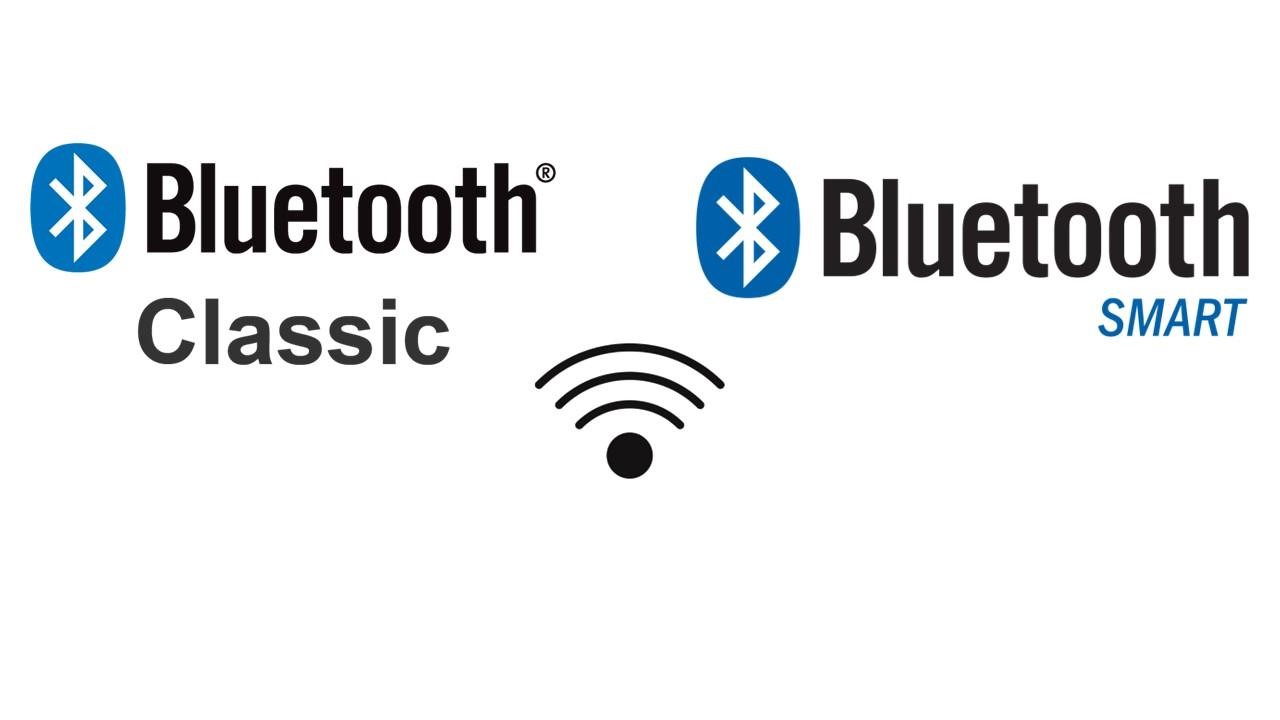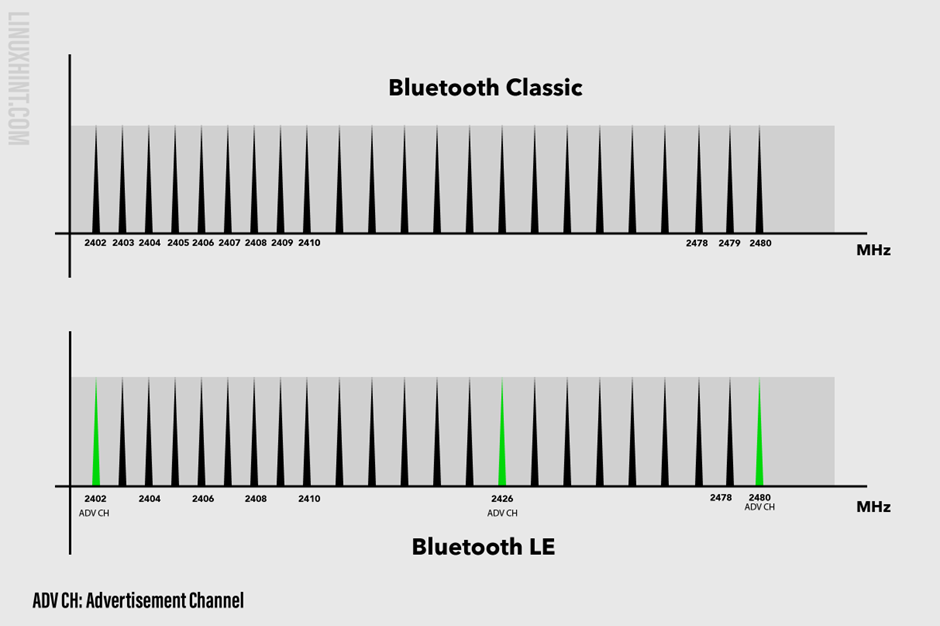What Is Bluetooth in ESP32
Bluetooth is a radio technology that transmits data within 2.4GHz bands. To transmit these data packets there are 79 designated channels each of 1 MHz in bandwidth. Bluetooth in ESP32 allows connecting multiple devices such as mobile phones, PCs, sensors, and many more.
Types of Bluetooth in ESP32
When it comes to types of Bluetooth, we should keep in mind the power consumption of Bluetooth because that’s the main reason behind division in Bluetooth technology. ESP32 is a low power IoT based microcontroller board where we have to keep the power as low as we can.
With the launch of Bluetooth technology till now there are multiple improvements and re-creation inside this technology. Depending upon the power consumption of Bluetooth we can divide it into two types:
Bluetooth Classic in ESP32
Bluetooth Classic is the basic or first variant of Bluetooth technology that has been here for the last 20 years. It is a wireless LAN technology that operates in 2.4Ghz bands and Bluetooth classic can be divided into two types based upon the data rate:
- Basic Rate (BR): It is the standard radio modulation having 1MB/s data transfer rate. It is used for transmitting audio and sometimes video.
- Enhanced Data Rate (EDR): It was introduced to increase data transfer rate from 1MB/s to 3MB/s that allows it to operate high end CODECs.
Both Bluetooth Classic and BLE operate in the 2400-2483.5 MHz range within the ISM 2.4 GHz frequency band. However Classic Bluetooth communication happens over any one of 79 channels on the other hand BLE has only 40 designated channels.
The high data transfer rate of Bluetooth classic helps it to carry high quality audio which is not possible in BLE. Supporting point-to-point communication, Bluetooth classic has become standard for audio streaming, headphone, and in-car entertainment systems.
Following are some major applications of Bluetooth Classic:
- Transferring files between devices
- Hands-free calling
- Wireless speakers
- Wireless headsets
- Wireless keyboards and printers
Bluetooth Low Energy (BLE) in ESP32
BLE (Bluetooth Low Energy) or Bluetooth 4.0 is the upgraded version of basic Bluetooth technology that came into market in 2011. From the name BLE we can conclude that it is a low-energy version of Bluetooth technology. BLE consumes very less power and is a perfect fit for boards like ESP32.
Unlike Bluetooth Classic it doesn’t remain on all the time rather it goes to sleep mode and only enables when connection is initiated, this helps pretty much in saving a large amount of power. With its low energy capability ESP32 can exchange small amounts of data from sensors without any need of extra power. As it can run for a long time consuming very low power.
Here is a list of BLE applications:
- Blood pressure monitoring
- Fitness devices
- Monitoring sensors
- Geofencing advertising
- Home security sensors
- IoT based applications
Brief Comparison of Bluetooth Classic and Bluetooth Low Energy
Key difference here is Bluetooth consumes a large amount of power and transfers high quality data while Bluetooth Low Energy does not need to exchange large data and can run on batteries for years. Let’s discuss the comparison based on various parameters.
Power Consumption
Bluetooth low energy has the main feature of low power consumption as it enables devices to run for more than a year by just using a single coin cell battery. This happens because BLE devices remain in sleep mode throughout, it only wakes up when data needs to be transmitted. Maximum current consumption is only 15mA.
BLE – Winner
Range of the Device
When it comes to range of Bluetooth the winner is Bluetooth Classic as its opponent consumes very less power which enables it to work for a longer period on a single cell, but this feature reduces the range of Bluetooth devices. So, if one needs a longer range, he has to consider Bluetooth classic.
Classic Bluetooth – Winner
Throughput
The actual data transfer rate for Bluetooth Low Energy is around 100 – 250 Kbps as compared to Classic Bluetooth which is around roughly 2 Mbps. Therefore, transferring high quality audio video data cannot be transferred using the BLE. Classic Bluetooth is the way to go. However, for low data transfer with less power and latency BLE is the best fit.
Classic Bluetooth – Winner
Cost
BLE devices as compared to devices having Bluetooth Classic are very much cheaper. This is possible because BLE is designed for low power consumption applications and hence has less data transfer rate and speed. On the other hand, Bluetooth Classic has complicated protocols which require large batteries to transfer data and hence are relatively expensive.
BLE – Winner
Number of Slaves Attached to the Master
BLE devices supports a greater number of slaves devices in comparison to other versions. It all depends upon the implementation of BLE and memory size availability inside the devices.
BLE – Winner
Connection Setup Speed
BLE is easy to set up, robust and reliable. As most of us wear classic Bluetooth smart bands. The seamless connectivity between smart band and smartphone is only possible because of BLE. All these smart devices keep connected to other devices for a longer period only because of BLE.
Also, most features of Low Energy Bluetooth are taken from Classic Bluetooth technology such as adaptive frequency. BLE like Classic Bluetooth uses the same technology for not only pairing devices but also features advanced security authentication and data encryption. All these features make BLE more reliable than Classic Bluetooth.
From this comparison we can conclude that BLE beats Classic Bluetooth in most terms. However, at the end it all depends upon the usage and user preference to whether use BLE or Classic Bluetooth.
BLE – Winner
Here we have enlisted a brief comparison of Bluetooth Classic and BLE:
| Feature | Bluetooth Classic | Bluetooth Low Energy (BLE) |
|---|---|---|
| Data rate | 1Mbps for B 2-3Mbps for EDR | Up to 1Mbps |
| Power Consumption | High (up to 1W) | Low (0.01W-0.5W) |
| Audio Streaming | Original audio protocol used in most of devices | New LE audio protocol will replace the classic protocol because of low energy requirements and easy to handle |
| Range | Limited range 10m – 50m | Long range introduced in Bluetooth 5.0 up to 1km in line of sight |
| RF bandwidth | 2.4 GHz ISM band (2400-2483.5 MHz) | 2.4 GHz ISM band (2400-2483.5 MHz) |
| Number of channels | 79 RF channel each of 1MHz | 40 RF channel each of 2MHz |
| Modulation Technique | GFSK for Basic data rat 8-DPSK or π/4-DQPSK for Enhanced data rate | GFSK |
| Topology | Peer to peer (1:1) | Peer to peer (1:1) Star topology (many:1) Broadcast (1:many) Mesh (many:many) |
Conclusion
ESP32 has dual Bluetooth technology having both Classic and Low Energy version of Bluetooth. Bluetooth Classic is a basic variant of Bluetooth that consumes more power while Bluetooth Low Energy targets the low power applications such as exchanging data from sensors at regular intervals. This article covers the brief comparison of both ESP32 Bluetooth technologies.


